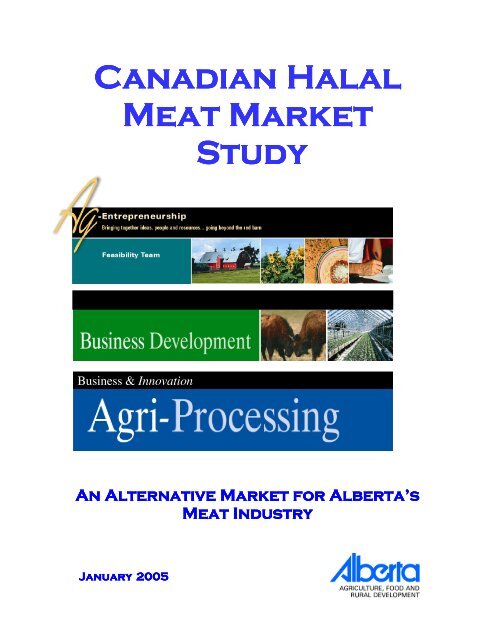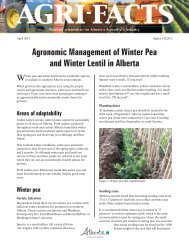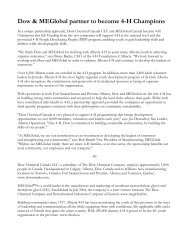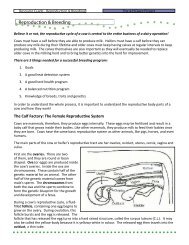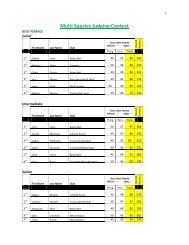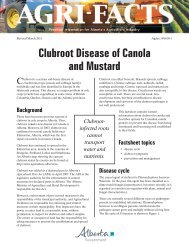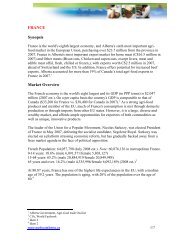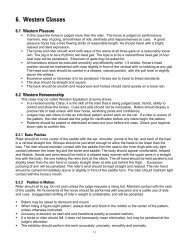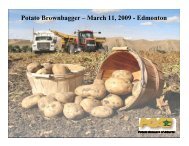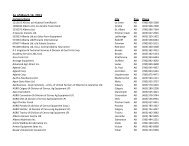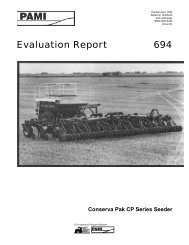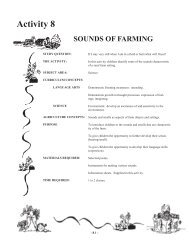Canadian Halal Meat Market Study - Agriculture and Rural ...
Canadian Halal Meat Market Study - Agriculture and Rural ...
Canadian Halal Meat Market Study - Agriculture and Rural ...
You also want an ePaper? Increase the reach of your titles
YUMPU automatically turns print PDFs into web optimized ePapers that Google loves.
Business & InnovationBusiness & Innovation
The <strong>Canadian</strong> <strong>Halal</strong> <strong>Meat</strong> <strong>Market</strong>_____________________________________________________________________________________________AcknowledgementsThe project team is grateful to the many people who assisted them throughout the development,implementation <strong>and</strong> completion of the “<strong>Canadian</strong> <strong>Halal</strong> <strong>Meat</strong> <strong>Market</strong>: An Alternative <strong>Market</strong> forAlberta’s <strong>Meat</strong> Industry.” A special acknowledgement goes out to the following organizations<strong>and</strong> people:• Farming For the Future On Farm Demo (FFF) for partial funding for the project.• Lakel<strong>and</strong> Poultry Inc. for administering the FFF funds.• Joan Bates, Administrative Support, Agri-Processing Branch, for her excellent computerskills <strong>and</strong> extensive time spent entering all the data from the 200 returned surveyquestionnaires into an excel spreadsheet.• AAFRD Staff, numerous Agri-Processing, Investment, Business Development, PrintMedia <strong>and</strong> Mail/Shipping staff assisted the project team in preparing the survey for mailout.• Survey Operations Team (Maureen Wenger <strong>and</strong> Melodie Mynzak), Economics <strong>and</strong>Competitiveness Division for reviewing <strong>and</strong> providing valuable feedback into thedevelopment of the survey questionnaire.Project TeamHicham Aitelmaalem, Financial StrategistFeasibility TeamAg-Entrepreneurship DivisionPatti Brel<strong>and</strong>, Project CoordinatorBusiness Development BranchBusiness <strong>and</strong> Innovation DivisionLeona Reynolds-Zayak, <strong>Market</strong> AnalystAgri-Processing BranchBusiness <strong>and</strong> Innovation Division1/20/2005 2
The <strong>Canadian</strong> <strong>Halal</strong> <strong>Meat</strong> <strong>Market</strong>_____________________________________________________________________________________________Executive SummaryAlberta <strong>Agriculture</strong>, Food & <strong>Rural</strong> Development (AAFRD) <strong>and</strong> Farming For The Future FarmDemo Project (FFF) funded the <strong>Canadian</strong> <strong>Halal</strong> <strong>Meat</strong> <strong>Market</strong>: An Alternative <strong>Market</strong> forAlberta’s <strong>Meat</strong> Industry. The objective of the project is to qualify <strong>and</strong> quantify the marketopportunities for Alberta meat producers <strong>and</strong> processors to supply halal meat within Canada.The information contained in this report was obtained from both primary <strong>and</strong> secondary research.The primary research entailed the development <strong>and</strong> implementation of a written consumer surveytargeting Muslim households in Toronto, Ottawa, Vancouver, Calgary <strong>and</strong> Edmonton.Secondary research entailed data gathering from trade magazines, business <strong>and</strong> governmentsources.The <strong>Canadian</strong> domestic halal meat market value is estimated to be $214 million with an averageannual household expenditure of $1623. Muslims are ardent consumers of meat <strong>and</strong> meatproducts, with feast days <strong>and</strong> celebrations that often include several different meat dishes. Onaverage, Muslim households spend $31 per week on halal meat products. This is almost doublethe <strong>Canadian</strong> household meat expenditure of $17 per week. (Statistics Canada, 2003). Thisdifference in weekly household expenditures may partially be explained by the difference inaverage household size. The survey respondents’ average household size was 4.4 people perhousehold where as the <strong>Canadian</strong> Food Expenditure study’s average household size is 2.5 peopleper household (CMHC, 2004 <strong>Canadian</strong> Housing Observer).In response to the growing demographics of the Muslim population in Canada, the dem<strong>and</strong> forhalal meat is predicted to demonstrate consistent growth rate. According to 2001 <strong>Canadian</strong>census, there are approximately 600,000 Muslims in Canada <strong>and</strong> an estimated 8 to 11 million inthe United States with a purchasing power of $12 billion (US). (AJR Consulting Inc., 2004) The<strong>Canadian</strong> Muslim population is expected to double by the end of this decade (Statistics Canada)<strong>and</strong> by the year 2025, 30% of the world’s population is expected to be Muslim. (CIA World FactBook, 2000)The average <strong>Canadian</strong> Muslim household consumes 5.6 meat servings per day. <strong>Halal</strong> beef <strong>and</strong>chicken are the most widely consumed followed closely by lamb <strong>and</strong> goat. Out of all consumedmeat cuts, ground beef ranks first at 16% followed by chicken legs (15%) then bone-in beef <strong>and</strong>whole chicken (14%). Boneless beef st<strong>and</strong>s in fifth place (12%), followed closely by chickenbreast (11%), then beef steak <strong>and</strong> chicken drums at 10%.Consumers purchasing decisions are primarily influenced by their confidence that the meat ishalal. Price was the third ranked attribute to influence purchasing decisions. The majority of<strong>Canadian</strong> Muslims (74%) would pay a premium of at least $0.50 per pound over “regular” meat.Thirteen percent seem to be willing to pay at least a premium of $1.50 per pound for qualityhalal meat.The <strong>Canadian</strong> halal meat industry is fragmented. Approximately 15% of Canada’s federallyinspected cattle slaughter <strong>and</strong> 35% of calf slaughter is processed in <strong>Halal</strong> certifiedestablishments. Alberta’s largest halal food processor, AL-NOOR Canada Inc., manufactures1/20/2005 3
The <strong>Canadian</strong> <strong>Halal</strong> <strong>Meat</strong> <strong>Market</strong>_____________________________________________________________________________________________halal meat <strong>and</strong> cheese. Prior to the USA export restraints associated with BSE, AL-NOORCanada Inc., exported 95% of its total production to the USA. Beef based product wasapproximately 40% of it product line. (AJR Consultants Inc., 2004).Although some halal meat products can be found in large grocery retail outlets throughoutCanada, the primary halal meat retail channel is small, privately owned halal meat shops locatedin larger urban centers. Each individual shop is responsible for acquiring its supply of halal meatthrough local processors <strong>and</strong>/or abattoirs. It was reported, that there was concern withinconsistent quality.While this study suggests that there is potential for Alberta meat processors to supply the Muslimethnic market, underst<strong>and</strong>ing Islam’s halal requirements <strong>and</strong> international business protocols isnecessary for the processor to successfully enter this market.Even though there are two distinct sectors within Islam, (Sunni <strong>and</strong> Shi`i), Muslim meatconsumption is based on the Quan’an, hadiths (traditions), various legal schools <strong>and</strong> culturaldistinctions. Successful market entry will depend on:• Adherence to the religious laws of Islam. It is essential to implement the principles ofhalal slaughter. As the legitimacy of the label “halal” is fundamental, it is recommendedto work with a Muslim certifying body.• Packaging, shipping <strong>and</strong> storage should be addressed. <strong>Halal</strong> products must be processedin conditions that are free from contamination from haram (illegal) products such asblood, blood-related products, pork or non-halal products.• <strong>Market</strong>ing strategies aimed at the halal market will have to be transparent <strong>and</strong> encouragetrust <strong>and</strong> loyalty in their relationships <strong>and</strong> business practices.1/20/2005 4
The <strong>Canadian</strong> <strong>Halal</strong> <strong>Meat</strong> <strong>Market</strong>_____________________________________________________________________________________________Table of ContentsAcknowledgements......................................................................................................................... 2Project Team ................................................................................................................................... 2Executive Summary........................................................................................................................ 3Table of Contents............................................................................................................................ 5Introduction..................................................................................................................................... 7Background..................................................................................................................................... 7Islam............................................................................................................................................ 7Sunnis...................................................................................................................................... 8Shi`is ....................................................................................................................................... 8Other Islamic Groups.............................................................................................................. 9Islamic Food Requirements ........................................................................................................ 9Conditions of <strong>Halal</strong>............................................................................................................... 10Research Methodology ................................................................................................................. 10Primary Research...................................................................................................................... 10Sample Design ...................................................................................................................... 10Questionnaire Design............................................................................................................ 11Data Collection <strong>and</strong> Statistical Reliability............................................................................ 11<strong>Study</strong> Results ................................................................................................................................ 12<strong>Market</strong> Value ............................................................................................................................ 12Figure 1: <strong>Canadian</strong> <strong>Halal</strong> <strong>Meat</strong> <strong>Market</strong> Value.................................................................. 12Industry ..................................................................................................................................... 12Figure 2: Current <strong>Halal</strong> Distribution Channels................................................................. 13Consumer Demographics.......................................................................................................... 13Product Definition..................................................................................................................... 13Purchasing Considerations.................................................................................................... 13Figure 3: Importance of Consuming <strong>Halal</strong> <strong>Meat</strong> .............................................................. 14Figure 4: Frequency of <strong>Halal</strong> <strong>Meat</strong> Consumption ............................................................ 14Figure 5: Factors Influencing the Consumption of <strong>Halal</strong> <strong>Meat</strong> ........................................ 14Figure 6: Purchasing Frequencies..................................................................................... 15Household Consumption....................................................................................................... 15Figure 7: Average <strong>Halal</strong> <strong>Meat</strong> Servings Per Day.............................................................. 15Product Consumption............................................................................................................ 15<strong>Meat</strong> Variety <strong>and</strong> Cuts ...................................................................................................... 15Figure 8: Beef Product Consumption ............................................................................... 16Figure 9: Chicken Product Consumption.......................................................................... 16<strong>Halal</strong> <strong>Meat</strong> Product Attributes .......................................................................................... 17Figure 10: Excellence of <strong>Halal</strong> <strong>Meat</strong> Quality ................................................................... 17Figure 11: Preferred <strong>Halal</strong> <strong>Meat</strong> Product Properties......................................................... 17Figure 12: Antibiotics <strong>and</strong> Growth Hormones.................................................................. 18Price .................................................................................................................................. 18Figure 13: Current Premium Perception........................................................................... 18Restaurant Expenditures ....................................................................................................... 19Processed <strong>Meat</strong> ..................................................................................................................... 19Figure 14: Processed <strong>Meat</strong>s .............................................................................................. 19Geographic Implications....................................................................................................... 191/20/2005 5
The <strong>Canadian</strong> <strong>Halal</strong> <strong>Meat</strong> <strong>Market</strong>_____________________________________________________________________________________________Figure 15: Monthly <strong>Halal</strong> <strong>Meat</strong> Expenditures .................................................................. 20Other Survey Findings .......................................................................................................... 20<strong>Study</strong> Summary/Recommendations.............................................................................................. 20References..................................................................................................................................... 22Appendix 1: Survey ...................................................................................................................... 231/20/2005 6
The <strong>Canadian</strong> <strong>Halal</strong> <strong>Meat</strong> <strong>Market</strong>_____________________________________________________________________________________________IntroductionThe “<strong>Canadian</strong> <strong>Halal</strong> <strong>Meat</strong> <strong>Market</strong>: An Alternative <strong>Market</strong> for Alberta’s <strong>Meat</strong> Industry” is thesecond part of a Farming For the Future On Farm Demo Program (FFF) “Muslim ConsumerDriven <strong>Meat</strong> Value Chain”. The study is a national Muslim consumer research study, whichqualifies <strong>and</strong> quantifies the <strong>Canadian</strong> halal meat market. The study defines the opportunities <strong>and</strong>challenges of supplying halal meat to Muslim consumers in Canada. This report addresses:• What is the market potential for halal meat products?• What are the demographic, economic <strong>and</strong> lifestyle characteristics of the consumer?• What are the purchasing patterns of the consumer (where <strong>and</strong> when they purchase,quantity of meat purchased)?• What product attributes do they want - size, frozen, fresh, whole, cut-up, packaging,quality, additional processing, etc?• Are they willing to pay more for a halal meat? How much more would they be willing topay?• Is there an opportunity for a new processor to serve the halal market?BackgroundIt is estimated that there will be over one billion adherents to the Islamic religion all around theworld early in this millennium. In France, Muslims have become the second largest religion <strong>and</strong>in the United States they are reported to be over 8 million Muslims.According to 2001 <strong>Canadian</strong> census, there are approximately 600,000 Muslims in Canada <strong>and</strong> anestimated 8 to 11 million in the United States with a purchasing power of $12 billion (US). (AJRConsulting Inc., 2004) The <strong>Canadian</strong> Muslim population is expected to double by the end of thisdecade (Statistics Canada) <strong>and</strong> by the year 2025, 30% of the world’s population is expected to beMuslim. (CIA World Fact Book, 2000)IslamThe religion brought to Arabia by the Prophet Muhammad during his lifetime (570-632 C.E.) iscalled Islam, the religion of peace. It established certain minimum legal requirements forbelievers <strong>and</strong> laid down rules for daily life so that people could live in a religious way.All Muslims look to the Qur’an, the Holy Book of Islam, as the basis for their faith. The hadithor traditions of the Prophet Muhammad are the basis for the development of Islamic law whichled to various legal schools e.g. Hanafi, Maliki, Shafi`i, <strong>and</strong> Hanabali.While every Muslim accepts the basic ways of being Muslim, like the Christian division betweenthe Catholics <strong>and</strong> Protestants, Islam has two distinctions in faith. They are the Sunni <strong>and</strong> Shi`isectors of Islam. (Waugh, 2002)1/20/2005 7
The <strong>Canadian</strong> <strong>Halal</strong> <strong>Meat</strong> <strong>Market</strong>_____________________________________________________________________________________________Sunnis constitute the largest number in the world (about 80%), but some areas have a predominance ofShi`i believers, as for example, in Iran.SunnisSunnis come from many different countries, such as Egypt, Jordan, Pakistan, India, Malaysia,Philippines, Palestine, etc. <strong>and</strong> make up about 75% of the Muslim population in Canada.Their religious buildings are called mosques or masjids. Mosque councils run all activities inthese buildings <strong>and</strong> the president of the mosque council normally speaks on behalf of thecommunity on matters of business.The basic requirements of proper eating for the Sunni depend upon the guidance in the Qur’an,the hadith <strong>and</strong> the four schools of law, Hanafi, Maliki, Shafi`i, <strong>and</strong> Hanabali. While Sunnispractice their Islam together, cultural distinctions play an important role in the food they eat.Once food has been designated as legally acceptable (halal), taste <strong>and</strong> ethnic preferencesdetermine how it will be used.Sunnis accept cultural <strong>and</strong> language differences with openness, but they are less tolerant ofminority groups within Islam speaking for them. For example, they are resistant to allowingsmall groups like the Ahmadiyya, an Indian sub-continent group with claims for an inspiredleader beyond the Prophet Muhammad, to speak for Sunnism, even though the latter groupclaims to be Sunni. Businesses who hope to trade with Sunnis should be aware of these internalattitudes. Ahmadis, however, adhere to the same rules in food as their other brethren. (Waugh,2002)Shi`isShi`is are associated with four principal areas in the world (Iran, Iraq, the Yemen <strong>and</strong> South EastAsia). Shi`is believe that a spiritual individual designated directly by God should head theMuslim community. This person is given the title of imam, but the role assigned to him is muchdifferent than that found in Sunnism. The Shi`i imam is regarded as having full, complete control<strong>and</strong> has the final say on how the community should live out its Islamic life.The Shi`is look to an inspired leader from the Prophet’s line as the true head of the community.There are some differences among the Shi`i as to which imam is the correct one. All divisionswithin the Shi`a tradition are found in Canada, therefore, one will find Twelvers, Fivers, <strong>and</strong>Seveners (indicating differences on the number of imams held to be in the lineage).The largest group among Shi`is are the Twelvers, designated because their imam’s line hadtwelve visible imams. They are centred in Iran, but they are also found in Iraq, Pakistan <strong>and</strong>India. The Twelver population in Canada comprises of about 15% of all Muslims. The tiniestrepresentation (less than 2% of the Muslim population in Canada) is the Fivers; these areYemenis who have a different interpretation of who the imam is.1/20/2005 8
The <strong>Canadian</strong> <strong>Halal</strong> <strong>Meat</strong> <strong>Market</strong>_____________________________________________________________________________________________The most powerful group of Shi`is in Canada is the Isma`ilis (known as ‘Seveners’). They makeup about 9% of the Muslim population in Canada. Their interpretation of ‘imam’ focuses upon acertain line (seven from the Prophet) from which the Aga Khan is said to descend. He runs theinternational organization from Paris. Isma`ilis have been extraordinarily financially successfulin Canada. They are internationally well organized from the top down, in contrast with the otherMuslim groups who invest much of their structure in the local community. Isma`ilis onlyoperate on the authority of the Aga Khan <strong>and</strong> the rules issued by his office <strong>and</strong> they do notaccept Sunni interpretations on food. Most adhere to Muslim rules on pork, but they are lessconcerned about other matters.It is important to know that all Shi`is are reluctant to allow other groups, especially Sunnis, tospeak for them. Even though Twelvers have very few differences with Sunnis over theapplication of food rules, they, nevertheless, have their own authorities <strong>and</strong> they cite them whendiscussing these issues. Generally speaking, though, they buy the same Islamically validatedfood as the Sunnis. (Waugh, 2002)Other Islamic GroupsThe Druze are adherents of a religion from Palestine, Lebanon <strong>and</strong> Syria in the Middle East whohave a particular interpretation deriving from Islamic tradition. With an internal familyorientation,faith is determined by a group of elders within the community. They usually areclosely allied with Sunnis from the same areas of the Middle East, sharing the same language<strong>and</strong> culture. They usually adhere to Muslim rules of food.Sufis cut across both Sunni <strong>and</strong> Shi`i lines. Stressing mystical themes, inner fulfillment <strong>and</strong>loyalty to an inspired leader, they have attracted some converts among <strong>Canadian</strong>s. Many Sufigroups adhere to Muslim dietary rules.The Baha`is arose out of Shi’i tradition in Iran <strong>and</strong> eventually separated from them completely.Some of the local people who were raised in Iran still practice Muslim dietary rules; the NorthAmerican converts seldom do. These rules are regarded as culturally determined (rather thanreligiously-determined) by the Baha`is. (Waugh, 2002)Islamic Food RequirementsIn Islam, there are two terms that denote Islamic prohibitions or restrictions on food: haram <strong>and</strong>halal. The word 'halal'means lawful <strong>and</strong> permitted by or conforming to Islamic Law (DivineRules); ritually clean, healthy <strong>and</strong> proper. In the context of this study, halal meat means meatthat is permissible to eat based on Islamic Shari'ah.Opposite to halal is haram, which means unlawful or forbidden. Muslims are prohibited fromconsuming pork <strong>and</strong> alcohol because they are regarded as najis (unclean) <strong>and</strong> therefore areconsidered haram. For Muslim consumers, beef <strong>and</strong> poultry products must be deemed as halal<strong>and</strong> must originate from certified slaughterhouses that follow Islamic slaughter practices.1/20/2005 9
The <strong>Canadian</strong> <strong>Halal</strong> <strong>Meat</strong> <strong>Market</strong>_____________________________________________________________________________________________Conditions of <strong>Halal</strong>An animal or poultry has to be slaughtered in a ritual way known as Zabiha. Zabiha requires:• Animals to be alive <strong>and</strong> healthy at the time of slaughter. Therefore the animal should notbe suffering with any ailments or any lacerations <strong>and</strong> shooting, electrical shock, orhitting the animal on the head with a hammer is not permitted. To incur as little pain aspossible, <strong>and</strong> because carrion is forbidden the jugular vein, carotid artery <strong>and</strong> windpipehave to be severed by a razor sharp knife in a single swipe. The knife should be fourtimes the size of the animals’ neck <strong>and</strong> razor sharp. If possible the slaughterer <strong>and</strong> theanimal should face Quibla or Mecca.• The h<strong>and</strong> of a Muslim male who knows the skill of slaying <strong>and</strong> blessing must slaughteranimals or poultry.• All the flowing blood must be completely drained out of the carcass, as blood isforbidden.• Since pork is forbidden, halal slaughtering must not be done in the vicinity of porkslaughtering <strong>and</strong> processing.• Prior to slaughter, the animal must be fed <strong>and</strong> given water. Also, one animal must notsee the other being slaughtered.• Stunning an animal prior to slaughter is a controversial issue. There is concern thatstunning may kill the animal prior to slaughter, therefore rendering it haram orunsuitable for Muslims consumption.Research MethodologyThe information contained in this report was obtained from both primary <strong>and</strong> secondary research.The primary research entailed the development <strong>and</strong> implementation <strong>and</strong> analysis of a writtenconsumer survey targeting Muslim households in Toronto, Ottawa, Vancouver, Calgary <strong>and</strong>Edmonton. Although Montreal is home to the second largest Muslim population, the projectteam did not survey the community. The team was concerned with accurately translating thesurvey into French.Secondary research entailed data gathered from trade magazines, business <strong>and</strong> governmentsources.Primary ResearchSample DesignThe target survey respondents were adult <strong>Canadian</strong> Muslims responsible for the household foodexpenditures.The development of an accurate sample was challenging. Although there are a variety ofdirectories available through the mosques, Islamic organizations <strong>and</strong> Muslim communityorganizations, there was a concern that a survey population selected from any specific directorymay lead to survey bias. Therefore, Muslims household geographic density data <strong>and</strong> postal1/20/2005 10
The <strong>Canadian</strong> <strong>Halal</strong> <strong>Meat</strong> <strong>Market</strong>_____________________________________________________________________________________________codes of census track data with a Muslim population of 30% or greater were purchased fromStatistics Canada. Using the first three digits of the postal code <strong>and</strong> the languages mostcommonly spoken by Muslims, Canada Post developed a database. The project team then pickedup the database through Canada Post’s Online Business Center <strong>and</strong> r<strong>and</strong>omly selected 14,000homes from the delivery routes provided. The number of surveys distributed to each of themetropolitan areas was established based on its percentage of the national Muslim population:• Calgary – 7%• Edmonton – 5%• Vancouver – 3%• Toronto – 65%• Ottawa – 10%Questionnaire DesignLittle secondary data is available on the Muslim consumer, therefore, the project team designed asurvey questionnaire to:• Identify the dem<strong>and</strong> <strong>and</strong> estimate the value of the <strong>Canadian</strong> halal meat market;• Determine the cut, price, quality, <strong>and</strong> average consumption for beef, lamb, chicken <strong>and</strong>goat currently;• Develop an underst<strong>and</strong>ing of the attributes affecting the Muslim consumers purchasingdecisions;• Identify opportunities value-added meat products <strong>and</strong> food service products.A copy of the survey is included in Appendix A.Data Collection <strong>and</strong> Statistical ReliabilityOn March 15, 2004 the survey questionnaire was sent to the sample population as unaddressedad mail. To reduce sample error, the goal was to receive 600 completed questionnaires.However, due to the difficultly in reaching the <strong>Canadian</strong> Muslim population <strong>and</strong> the costassociated with sending a second survey notice, the project team chose to not send a surveyreminder. As of May 30, 2004 the project team received 200 questionnaires of which six wereincomplete <strong>and</strong> therefore discarded.The confidence levels, which are important indicators of the reliability of observed results, arebeing provided at a 95% confidence level <strong>and</strong> 7.03 confidence interval. However, in the analysisof findings, no specific reference is made to statistical significance, as such reference can bemisleading.1/20/2005 11
The <strong>Canadian</strong> <strong>Halal</strong> <strong>Meat</strong> <strong>Market</strong>_____________________________________________________________________________________________<strong>Study</strong> Results<strong>Market</strong> ValueThe <strong>Canadian</strong> domestic halal meat market value is estimated to be $214 million with an averageannual household expenditure of $1623. Muslims are ardent consumers of meat <strong>and</strong> meatproducts, with feast days <strong>and</strong> celebrations that often include several different meat dishes. Onaverage, Muslim households spend $31 per week on halal meat products. This is almost doublethe <strong>Canadian</strong> household meat expenditure of $17 per week. (Statistics Canada, 2003). Thisdifference in weekly household expenditures may partially be explained by the difference inaverage household size. The survey respondents’ average household size was 4.4 people perhousehold where as the <strong>Canadian</strong> Food Expenditure study’s average household size is 2.6 peopleper household (CMHC, 2004 <strong>Canadian</strong> Housing Observer).Figure 1: <strong>Canadian</strong> <strong>Halal</strong> <strong>Meat</strong> <strong>Market</strong> Value<strong>Canadian</strong> <strong>Halal</strong> <strong>Meat</strong> <strong>Market</strong> ValueLower Average UpperTotal <strong>Market</strong> Value $177,162,986 $213,791,301 $249,107,858<strong>Market</strong> Value/Household $1,345 $1,623 $1,891Household Weekly Expenditure $26 $31 $36<strong>Canadian</strong> Average (2001 - Statistics CanadaIncome Statistics Division, Catalogue no.62-554-XIE) $17.34IndustryThe <strong>Canadian</strong> halal meat industry is fragmented. Approximately 15% of Canada’s federallyinspected cattle slaughter <strong>and</strong> 35% of calf slaughter is processed in <strong>Halal</strong> certifiedestablishments. Alberta’s largest halal food processor, AL-NOOR Canada Inc., manufactureshalal meat <strong>and</strong> cheese. Prior to the USA export restraints associated with BSE, AL-NOORCanada Inc., exported 95% of its total production to the USA. Beef based product wasapproximately 40% of it product line. (AJR Consultants Inc., 2004).Although some halal meat products can be found in large grocery retail outlets throughoutCanada, the primary halal meat retail channel is small privately owned halal meat shops locatedin larger urban centers. Each individual shop is responsible for acquiring its supply of halal meatthrough local processors <strong>and</strong>/or abattoirs. Currently, 85% of respondents trust the halal meatthey currently buy from their local halal meat store is 100% halal. However, it was reported, thatthere was concern with inconsistent quality.When survey participants were asked if they would purchase halal meat from large grocery retailoutlets stores such IGA, Safeway, Superstore etc, 74% reported that they would be willing topurchase halal meat from them if the packaging displays a halal tag or logo. The majority ofrespondents (69%) stated they trust the display of a halal logo on packaged meat means that themeat is 100% halal. Only 15% stated they would not buy halal meat from supermarkets.1/20/2005 12
The <strong>Canadian</strong> <strong>Halal</strong> <strong>Meat</strong> <strong>Market</strong>_____________________________________________________________________________________________Even though 34% of respondents said they would purchase halal meat from the Internet if thehalal meat was cheaper than in retail outlets, 39% would not buy it from the Internet regardlessof the price.Figure 2: Current <strong>Halal</strong> Distribution Channels<strong>Halal</strong> <strong>Meat</strong> Distribution Channels%<strong>Halal</strong> <strong>Meat</strong> Shops 85.1Grocery Stores 24.7Farmer/Auction Mart 9.3Kosher Stores 2.6Other 10.3Consumer DemographicsIt is assumed that males are the person responsible for meat expenditures as the surveyrespondents were primarily male. Other demographic characteristics identified in the surveyresponses were:• Immigrated to Canada within the last ten years• Annual income below $50,000• Well educated with 74% having at least a post-secondary degree or diploma <strong>and</strong> 45%with a graduate degree/post-doctorate;• Average household size – 4.4 people per household• Monthly halal meat expenditures ranged $50 to $199 per month• Attend mosques at least once a week.Product DefinitionPurchasing ConsiderationsConsumption of halal meat is an integral part of the <strong>Canadian</strong> Muslims’ religion <strong>and</strong> culture.Therefore, the main factor influencing <strong>Canadian</strong> Muslim’s meat purchasing decisions is havingconfidence <strong>and</strong> trust that the product is halal. This is supported by:• 88% stated it is very important to consume halal meat (Figure 3)• 72% would only consume halal meat (Figure 4)• 71% (137/194) ranked halal as the number one purchasing consideration. (Figure 5)Only 3 % of respondents stated halal meat consumption is not at all important <strong>and</strong> they do notconsume halal meat.1/20/2005 13
The <strong>Canadian</strong> <strong>Halal</strong> <strong>Meat</strong> <strong>Market</strong>_____________________________________________________________________________________________Figure 3: Importance of Consuming <strong>Halal</strong> <strong>Meat</strong>Importance of <strong>Halal</strong> <strong>Meat</strong>Frequency %Very important 170 87.6Somewhat important 12 6.2Not really important 5 2.6Not at all important 6 3.1Undecided 1 0.5Total 194 100Figure 4: Frequency of <strong>Halal</strong> <strong>Meat</strong> Consumption<strong>Halal</strong> <strong>Meat</strong> ConsumptionFrequency %Consume halal meat 100% 140 72.2Consume halal meat 75 to 99% 25 12.9Consume halal meat 50 to 74% 13 6.7Consume halal meat 25 to 49% 5 2.6Consume halal meat 1 to 24% 5 2.6Do not consume halal meat 6 3.1Total 194 100Figure 5: Factors Influencing the Consumption of <strong>Halal</strong> <strong>Meat</strong>Factors Influencing Purchasing DecisionsFrequenciesRank <strong>Halal</strong> Quality Pricing Processor1 137 16 6 222 19 55 9 383 7 47 42 214 5 7 59 46The majority of the survey respondents reported that they prefer to purchase halal meat fresh(75%), once a week (42%), with most purchases being made Friday through Sunday. Thirtypercent of the respondents report purchasing meat once or twice a month <strong>and</strong> 25% purchasefrozen halal meat products.1/20/2005 14
The <strong>Canadian</strong> <strong>Halal</strong> <strong>Meat</strong> <strong>Market</strong>_____________________________________________________________________________________________Figure 6: Purchasing FrequenciesPurchasing FrequencyFrequency %Daily 3 1.52 or 3 times a week 35 18Once a week 81 41.8Twice a month 34 17.5Once a month 24 12.4Other 8 4.1Valid Responses 185 95.4Missing Responses 9 4.6Total 194 100Household ConsumptionThe average <strong>Canadian</strong> Muslim household consumes 5.6 meat servings per day. (Figure 7) Thereare as many Muslims consuming greater than four servings per day as there are Muslimsconsuming less than four servings per day. For the purpose of this study, a serving was definedas 140 grams of meat (a small chicken breast, one hamburger patty).Figure 7: Average <strong>Halal</strong> <strong>Meat</strong> Servings Per Day<strong>Halal</strong> <strong>Meat</strong>Servings Per DayMean 5.6Median 4Product Consumption<strong>Meat</strong> Variety <strong>and</strong> CutsAlthough the survey respondents ranked beef <strong>and</strong> chicken equally (28%) as their preferred halalmeat, Muslims who reported consuming halal meat one to five times a week, selected beef overchicken. Lamb <strong>and</strong> goat followed simultaneously. Muslims who reported consuming halalmeat more than six times a week, ranked the meats varieties in the following order: chicken,beef, lamb <strong>and</strong> goat.Muslims who reported consuming halal meat one to five times a week, selected ground beef astheir most consumed form of halal meat, followed by whole chicken. This tendency is reversedwhen halal meat is consumed more than six times a week.1/20/2005 15
The <strong>Canadian</strong> <strong>Halal</strong> <strong>Meat</strong> <strong>Market</strong>_____________________________________________________________________________________________The cuts of beef consumed ranked:• Ground beef (34%)• Cubed boneless beef (24%)• Steaks (22%)• Cubed beef with bone in (20%).Figure 8: Beef Product ConsumptionBeef Consumption40%35%30%25%20%15%10%5%0%Steak Ground beef Boneless With BonesThe Muslim consumer reported purchasing the following chicken products:• Legs (29%)• Whole (28%)• Breasts (22%)• Drums (21%).Figure 9: Chicken Product ConsumptionChicken Consumption35%30%25%20%15%10%5%0%Whole Chicken Chicken Legs Chicken Drums Chicken Breast1/20/2005 16
The <strong>Canadian</strong> <strong>Halal</strong> <strong>Meat</strong> <strong>Market</strong>_____________________________________________________________________________________________<strong>Halal</strong> <strong>Meat</strong> Product AttributesOnly 37% of the survey respondents completely agree that the halal meat they currently buy is ofexcellent quality. Whereas, 51% stated that they either somewhat agree or somewhat disagreethat the halal meat they currently buy is of excellent quality. Therefore, the survey implies thatMuslim consumers are unhappy with the quality of halal meat available at retail.Figure 10: Excellence of <strong>Halal</strong> <strong>Meat</strong> QualityExcellence of <strong>Halal</strong> <strong>Meat</strong> QualityFrequency %Completely agree 72 37.1Somewhat agree 98 50.5Somewhat disagree 9 4.6Completely disagree 2 1Valid Responses 181 93.3Missing Responses 13 6.7Total 194 100Most respondents like their meat to be somewhat pink, with some fat content to lean, <strong>and</strong> verytender.Figure 11: Preferred <strong>Halal</strong> <strong>Meat</strong> Product PropertiesPreferred <strong>Halal</strong> <strong>Meat</strong> Product PropertiesColor Fat Content Tenderness% % %1-light pink, lean, tender. 19.6 42.3 40.22 14.4 19.6 12.43 25.3 12.9 19.14 17 6.7 9.35 6.2 2.1 2.16-dark read, fat, tough. 5.2 1 2.1Valid Responses 87.6 84.5 85.1Missing Responses 12.4 15.5 14.9Total 100 100Most respondents (57%) would not buy halal meat coming from an animal that was treated withantibiotics <strong>and</strong>/or growth hormones, however a substantial number (26%) of respondents wouldstill consider buying meat that was treated with antibiotics <strong>and</strong>/or growth hormones.1/20/2005 17
The <strong>Canadian</strong> <strong>Halal</strong> <strong>Meat</strong> <strong>Market</strong>_____________________________________________________________________________________________Figure 12: Antibiotics <strong>and</strong> Growth HormonesAntibioticsGrowthHormonesAccumulativeFrequency Frequency %Completely disagree 63 101 42%Somewhat disagree 35 22 15%Somewhat agree 34 22 14%Completely agree 33 15 12%Valid Responses 165 160 84%Missing Responses 29 34 16%Total 194 194 388PriceThe majority of the survey participants believe they are currently paying a premium for halalmeat. It was reported that:• 50% believe they are paying a premium of $0.10 to $2.00 per pound• 9% believe they are paying over $2.00 per pound• 10% believe they are paying no premium.Figure 13: Current Premium PerceptionCurrent Premium PerceptionPremium per lbs Frequency %10c to 49c 13 6.750c to 99c 40 20.6$1 to $1.49 33 17$1.5 to $2 12 6.2Over $2 26 13.4Do not pay more 17 8.8Cheaper that non-halal 3 1.5Undecided 35 18Total Responses 179 92.3Missing Responses 15 7.7Total 194Forty-one percent reported a willingness to pay a premium of $0.50/lb, 19% stated they arewilling to pay a premium of $1/lb <strong>and</strong> 13% stated they are willing to pay a premium of at least$1.5 per lb. Although the majority of the survey participants are also willing to pay a premiumfor halal meat, 31% stated they should not pay any premium over regular non-halal meat.1/20/2005 18
The <strong>Canadian</strong> <strong>Halal</strong> <strong>Meat</strong> <strong>Market</strong>_____________________________________________________________________________________________Restaurant ExpendituresThe majority of survey respondents eat at least 1 to 5 meals per month at restaurants. Themajority of these meals are consumed at dinner (69%) <strong>and</strong> lunch (51%). Only a small number ofthe population (16%) eats breakfast at restaurants. When selecting a restaurant the availability of<strong>Halal</strong> meat was stated as being a very important consideration in their decision to dine out for75% of the survey respondents. Only two percent stated that it is not really important. Thesurvey also revealed, that 74% of survey participants would eat out more often if morerestaurants had halal meat available. Only 8% stated that the increased availability of halal meaton restaurant menus would not increase their decision to eat outside the home.Processed <strong>Meat</strong>Although half of the participants reported purchasing ready-made meals, the majority would liketo see an increased availability of processed meats. Figure 15 outlines the products they arerequesting.Figure 14: Processed <strong>Meat</strong>sProcessed <strong>Meat</strong>s%Winners 14.9Sausage 22.7Salami 22.7Luncheon meat 27.8Nuggets 30.4Patties 28.4All above 39.2None above 7.2Geographic ImplicationsTwenty-seven percent of Edmonton survey participants spend over $300 per month on halalmeat products as compared to Calgary 0%, Ottawa 8%, Toronto 4.5% <strong>and</strong> Vancouver 7.1%.Fifty-seven percent of Calgary Muslim participants spend from $50 to $99 compared to Ottawa25%, Toronto 30%, <strong>and</strong> Edmonton 33% <strong>and</strong> Vancouver 36%. Statistical testing revealed thatthese variations between cities are statistically significant <strong>and</strong> that they are not just due tochance. Further analysis confirmed that income level <strong>and</strong> the household size could indeedexplain 65% of these spending fluctuations between cities.1/20/2005 19
The <strong>Canadian</strong> <strong>Halal</strong> <strong>Meat</strong> <strong>Market</strong>_____________________________________________________________________________________________Figure 15: Monthly <strong>Halal</strong> <strong>Meat</strong> ExpendituresMonthly <strong>Halal</strong> <strong>Meat</strong> Expenditures$0$1 - $50 - $100 - $150 - $200 - $250 - Over$49 $99 $149 $199 $249 $300 $300Ottawa 0.0% 16.7% 25.0% 16.7% 16.7% 8.3% 8.3% 8.3%Toronto 0.0% 11.3% 30.1% 26.3% 14.3% 6.8% 6.8% 4.5%Edmonton 0.0% 6.7% 33.3% 6.7% 6.7% 0.0% 20.0% 26.7%Calgary 7.1% 7.1% 57.1% 7.1% 14.3% 7.1% 0.0% 0.0%Vancouver 0.0% 0.0% 35.7% 7.1% 28.6% 0.0% 21.4% 7.1%Total 0.5% 10.1% 32.4% 21.3% 14.9% 5.9% 8.5% 6.4%Other Survey FindingsAlso further analysis revealed the following interesting facts:• People who spend more on halal meat tend to eat out more at restaurants that are offeringhalal choices. As well they tend to buy more halal ready-made meals.• People who go more often to mosques tend to have the highest halal meat consumption.• Households in which the household head falls within the older age group tends to be lesslikely to eat out at restaurants, but tend be more likely to purchase ready-made meals withan increase in beef <strong>and</strong> goat consumption as opposed to chicken <strong>and</strong> lamb.• Households with higher income tend to be most likely to consume only halal meat <strong>and</strong>less likely to purchase frozen meat.• People with the higher average household size tend to be the less likely to eat out atrestaurants.• The perception of good quality halal meat increased with the level of trust toward thehalal meat supplier.• Households in which the household head lived longer in Canada tend to consume moreground beef <strong>and</strong> less chicken legs.<strong>Study</strong> Summary/RecommendationsAlthough market efforts to supply certified <strong>Halal</strong> products throughout Canada has been sporadic,this study suggests that there is potential for Alberta meat processors to supply the Muslim ethnicmarket. Alberta meat processors are well positioned to meet the requirements of Muslimcommunities <strong>and</strong> to becoming one of the leading suppliers of halal food products throughout theCanada. However, in order to capitalize on this opportunity an exceptional underst<strong>and</strong>ing ofinternational Islamic religious <strong>and</strong> business protocols is essential.Even though there are two distinct sectors within Islam, (Sunni <strong>and</strong> Shi`i), Muslim meatconsumption is based on the Quan’an, hadiths (traditions), various legal schools <strong>and</strong> culturaldistinctions. Successful market entry will depend on:1/20/2005 20
The <strong>Canadian</strong> <strong>Halal</strong> <strong>Meat</strong> <strong>Market</strong>_____________________________________________________________________________________________• Adherence to the religious laws of Islam. It is essential to implement the principles ofhalal slaughter. As the legitimacy of the label “halal” is fundamental, it is recommendedto work with a Muslim certifying body.• Packaging, shipping <strong>and</strong> storage should be addressed. <strong>Halal</strong> products must be processedin conditions that are free from contamination from haram (illegal) products such asblood, blood-related products, pork or non-halal products.• <strong>Market</strong>ing strategies aimed at the halal market will have to be transparent <strong>and</strong> encouragetrust <strong>and</strong> loyalty in their relationships <strong>and</strong> business practices.• Establishing a supply chain relationship between Alberta meat processors <strong>and</strong> the<strong>Canadian</strong> Muslim community could be beneficial to all parties.1/20/2005 21
The <strong>Canadian</strong> <strong>Halal</strong> <strong>Meat</strong> <strong>Market</strong>_____________________________________________________________________________________________ReferencesAJR Consulting Inc.. (February 13, 2004). Opportunity Assessment & Framework ForEthnic Food Processing In Alberta , Alberta <strong>Agriculture</strong>, Food <strong>and</strong> <strong>Rural</strong> DevelopmentCIA World Fact Book, 2000 http://www.cia.gov/cia/download.htmlStatistics Canada. (February 21, 2003). “Household Spending on Food” The Daily, retrievedfrom http://www.statcan.ca/Daily/English/030221/d030221a.htmStatistics Canada (2002) Census http://www.statcan.ca/1/20/2005 22
The <strong>Canadian</strong> <strong>Halal</strong> <strong>Meat</strong> <strong>Market</strong>_____________________________________________________________________________________________Appendix 1: Survey1/20/2005 23
This survey is designed to identify the <strong>Canadian</strong>Muslim consumer needs, the availability of halalmeat products <strong>and</strong> qualify the <strong>Canadian</strong> halal meatmarket. Your input is valuable to us. Please havethe primary purchaser of meat in your householdcomplete the following survey.All information provided will remain confidential<strong>and</strong> no individual responses will be reported. Onlygroup results will be analyzed <strong>and</strong> communicated.Also, no future contact will be made without yourconsent. Please refer to question 40 <strong>and</strong> 41 of thesurvey.1. I consider myself to be a Muslim.YesNoIf your answer is no, please stop here <strong>and</strong> wethank you for your time. It is not necessary toreturn this survey.2. How important is it to you, that the meat youconsume is processed following the halal/zabihahprocessing methods? (Please choose only one)Very importantSomewhat importantNot really importantNot at all importantDon’t Know/Undecided3. Please choose one of the statements that best fitsyour meat consumption habits at home?We consume halal meat 100% of the time.We consume halal meat 75 - 99% of the time.We consume halal meat 50 - 74% of the time.We consume halal meat 25 - 49% of the time.We consume halal meat 1 - 24% of the time.We do not consume halal meat.If you do not consume halal meat please proceedto question number 28, otherwise please continueon to question 4.4. On average how many servings per day of <strong>Halal</strong>meat does your household including yourselfconsume? One meat serving is equivalent to onesmall piece such as small chicken breast, onehamburger patty or one 140 grams steak.__________Number of servings per day per family<strong>Canadian</strong> <strong>Halal</strong> <strong>Meat</strong> <strong>Market</strong>5. On average, how much money do you spendmonthly on halal meat purchases?$0$1– 49$50 – 99$100 – 149$150 – 199$200 – 249$250 – 300Over $300 per month6. Please put a checkmark in the box that bestdescribes how many times per week your familyconsumes the following halal meat groups. Youranswer should be based on your family’s averageweekly halal meat consumption. (choose one per line)Number ofTimes/WeekBeefChickenLambGoat0 1-5 6-1011-15Over167. Please put a checkmark in the box that bestdescribes how many times per week your familyconsumes the following halal meat cuts. Your answershould be based on your family’s average weeklyhalal meat consumption.(choose one per line)Number ofTimes/WeekBeef SteakGround BeefBoneless Beef (cubed)Beef Cubes withbonesWhole ChickenChicken LegsChicken DrumsChicken BreastsOther (Please Specify)0 1-5 6-10 11-15Over168. In my opinion, the halal meat I currently buy is ofexcellent quality. (Please choose only one)Completely agreeSomewhat agreeSomewhat disagreeCompletely disagree
The <strong>Canadian</strong> <strong>Halal</strong> <strong>Meat</strong> <strong>Market</strong>_____________________________________________________________________________________________9. From 1 to 4, please place in order of importancethe following criteria for purchasing halal meat.(1 being the most important <strong>and</strong> 4 being the least15. On a scale of 1 to 4 (1 being completely disagree<strong>and</strong> 4 being completely agree), please rate thefollowing statements. (animal is defined as beef or chicken)important)<strong>Halal</strong> considerationsPlease circle one number on each line CompletelyDisagreeQuality considerationsI will buy meat coming from an animalPrice considerations1 2that was treated with antibioticsMuslim processor/owner3 410. For each of the following quality traits pleasecircle the number that mostly closely describes yourpersonal preference. (Please circle one number foreach quality trait)Color Light Pink 1 2 3 4 5 6 Dark RedFat Content Lean 1 2 3 4 5 6 FatTenderness Tender 1 2 3 4 5 6 Tough11. Where do you purchase your halal meatproducts?(Please choose all that apply)<strong>Halal</strong> <strong>Meat</strong> shopsGrocery stores (Safeway, Sobey’s, Superstore,Loblaws, IGA etc.)Purchase from a farmer or auction mart &slaughter at a processing facilityKosher storesOther: (Please specify)__________________________12. What days of the week do you prefer to purchaseyour halal meat? (Please choose all that apply)MondayTuesdayWednesdayThursdayFridaySaturdaySunday13. How often do you purchase your halal meatproducts?(Please choose only one)Daily2 or 3 times a weekOnce a weekTwice a monthOnce a monthOther: (Please specify)__________________________14. On a monthly average, what percentage of yourhalal meat would be purchased fresh? ______%I will buy meat coming from an animalthat received growth hormones.CompletelyAgree1 2 3 416. On average, how many meals per month do youeat at restaurants (not just halal restaurants)?MealBreakfastLunchDinnerNumber of times per month17. Please choose the statement that best fits theimportance of the availability of halal meat in yourchoice of restaurant. (Please choose only one)Very importantSomewhat importantNot really importantNot at all importantDon’t know/Undecided18. If you had more restaurant choices that offeredhalal meat, would you eat out more often in theserestaurants?YesNoDon’t know/Undecided19. Do you currently purchase ready-made mealsfrom your grocery store/halal store?(Ready-made meal is defined as food ready to be servedfor consumption that only needs minimal time forheating or cooking.)YesNo20. What processed halal meats would you like to seeavailable for purchase? (Choose all that apply)Wieners, SmokiesSausagesSalami, pepperoni, etc.Luncheon <strong>Meat</strong>s (sliced s<strong>and</strong>wich meat)Nuggets<strong>Meat</strong> pattiesAll of the aboveNone of the aboveOther: (Please specify)__________________________
The <strong>Canadian</strong> <strong>Halal</strong> <strong>Meat</strong> <strong>Market</strong>_____________________________________________________________________________________________21. In your opinion, is the price you currently payfor <strong>Halal</strong> meat fair?YesNoDon’t know/Undecided22. What premium do you think you are currentlypaying for halal meat? (Premium is defined as theprice difference between halal meat <strong>and</strong> non-halal meat)Please only choose one.$0.10 to $0.49/lb ($0.22 - $1.07/kg)$0.50 to $0.99/lb ($1.10 - $2.17/kg)$1.00 to $1.49/lb ($2.20 - $ 3.28/kg)$1.50 to $2.00/lb ($3.30 - $4.40/kg)Over $2.00/lbs (Over $4.40/kg)I don’t think I pay moreIt is cheaper than non-halal meatI don’t know/Undecided23. How much of a premium are you willing to payfor halal meat products as compared to what you arecurrently paying for non halal meat?$0.50/lb ($1.10/kg)$1.00/lb ($2.20/kg)$1.50/lb ($3.30/kg)$2.00/lb ( $4.40/kg)Other: (Please specify) ______________________24. What would influence your decision to purchasemeat products from a supermarket such as IGA,Safeway, Sobey’s, IGA, Loblaws etc? (Please chooseonly one)It must have a <strong>Halal</strong> tag or <strong>Halal</strong> logo.It does need to have <strong>Halal</strong> tag or logo. I wouldpurchase it as long as it is not forbidden byIslam, ie pork etc.It does not need to have a <strong>Halal</strong> tag or logo. Iwould buy any type of meat including porkproducts.I do not purchase halal meat products insupermarkets.25. I completely trust that the meat I purchase frommy halal butcher is 100% halal?YesNo26. I completely trust that the display of a <strong>Halal</strong> logoon packaged meat means that the meat is 100%<strong>Halal</strong>?YesNoDon’t know/Undecided27. Would you be willing to buy <strong>Halal</strong> meat online ifsuch a service is made available in Canada?Yes, but only if it is cheaperYes, even if it costs a bit moreYes, but only if it costs the same as I am payingnowNo. Why Not?__________________________28. Which of the following statements, if they werefound on a packaged halal meat product, wouldinfluence your decision to buy the product? (chooseonly one)<strong>Halal</strong>Slaughtered by h<strong>and</strong> by a MuslimSlaughtered according to Islamic RitesCertified by any organizationCertified by a specific organizationZabihahNone. If it is sold in a <strong>Halal</strong> meat store, Iassume that it has been prepared properlyNone. I do my own background research on thecompany <strong>and</strong> its practicesThe following demographic questions will help usclassify the gathered data.29. What is your gender?MaleFemale30. What is your marital status?Single or equivalentMarried or equivalent31. Which of the following age groups do you belongto?18 – 24 years25 – 34 years35 – 44 years45 – 54 years55 <strong>and</strong> over32. Were you born in Canada?YesNoIf yes, please go to question 34 <strong>and</strong> if no, pleasecontinue to next question.
The <strong>Canadian</strong> <strong>Halal</strong> <strong>Meat</strong> <strong>Market</strong>_____________________________________________________________________________________________33. Which of the following geographic areas are you 40. How often do you go to the mosque fororiginally from? (Please choose only one)prayer?(Please choose only one)AfricaDailyAsia2 or 3 times a weekAustraliaOnce a weekEuropeTwice a monthMiddle EastOnce a monthAmericasHoliday/EidOther34. How long have you lived in Canada?Less than 5 years5-10 years11 – 15 years16 – 20 yearsOver 20 years35. Which city do you currently reside in? (chooseonly one)OttawaTorontoEdmontonCalgaryVancouver36 Including yourself, how many people reside inyour household? _________________37. Which of the following represents the highestlevel of education you have completed?Prior to high schoolHigh school diplomaSome post secondaryPost-secondary degree/diplomaGraduate degree/post-doctorate38. Which of the following categories best describeyour total household income before taxes?Under $20,000$20,000 – 29,999$30,000 – 39,999$40,000 – 49,999$50,000 - 59,999$60,000 69,000$70,000 – 79,999$80,000 – 89,999$90,000 – 99,999$100,000 <strong>and</strong> over39. To which wing of Islam do you belong to?SunniSheiatSuffiOther (Please specify)______________________________The following 2 questions are optional:41. I am interested in receiving a copy of the resultssummary.YesNo42. I would be willing to participate in future halalmeat surveys if required.YesNoIf you answered yes, to either question 40 or 41please provide your name <strong>and</strong> address below.Name: ___________________________Address: _________________________________________________________________________________Phone: ___________________________E-mail ____________________________Thank you for your time!!The personal information collected on this formwill be used only for the purposes as indicated inquestions 40 <strong>and</strong> 41 of this survey <strong>and</strong> is collectedunder the authority of the Freedom of Information<strong>and</strong> Protection of Privacy (FOIP) Act <strong>and</strong> issubject to the FOIP Act. If you have any questionsabout the collection, contact HichamAitelmaalem, Financial Strategist, Alberta<strong>Agriculture</strong>, Food <strong>and</strong> <strong>Rural</strong> Development,4709-44 Ave, Stony Plain, AB (780) 968-3550,e-mail: hicham.aitelmaalem@gov.ab.ca


